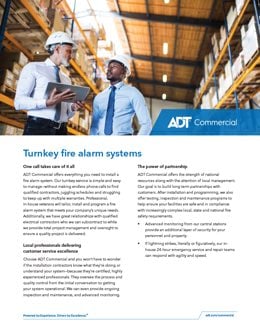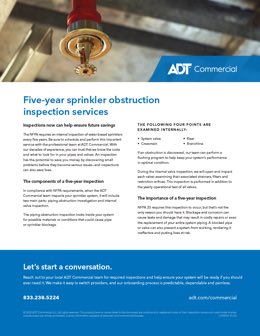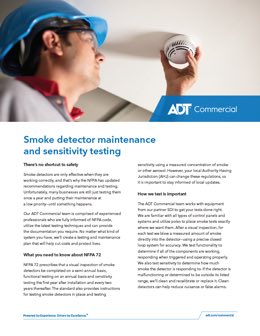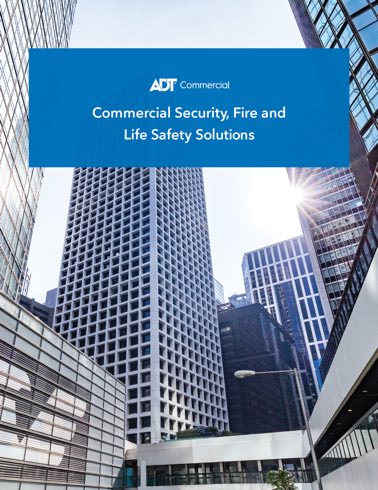* NFPA 2018 Reporter’s Guide: The Consequences of Fire, United States Fire Administration 2018
The prompt and safe evacuation of building occupants and immediate notification of the fire department are the primary means to prevent loss of life, as well as loss of property. The principles for saving building occupants from a fire are delineated in NFPA 101, Life Safety Code, and NFPA 72 for fire alarm systems.
Working in tandem with the alarm and detection systems are sprinkler systems. When inspected and maintained properly, and ensured they haven’t been tampered with, sprinkler systems are designed to extinguish a fire. When a certain temperature is reached, a sprinkler head will activate and water will begin flowing, helping to put out the fire. NFPA 25 covers inspection requirements for sprinkler systems. Compliance helps maximize system integrity to avoid failure and ensure fast, effective response to a fire emergency.
Another layer of protection is required, often referred to as “defend in place.” In the event that a life safety system fails, is tampered with, or in a situation in which occupants in a facility cannot be easily evacuated, as is the case for the ambulatory, elderly, incarcerated and others, passive fire protection can play a key role in saving lives.
This oft-neglected additional layer called Passive Fire Protection (PFP) can help compartmentalize a fire to its origin as well as help to slow the spread of fire and toxic gases to other areas of the building. The most commonly cited codes associated with passive fire protection are NFPA 80, 105 and 90A. NFPA 80 covers the installation, care and maintenance of many types of fire doors and opening protectives. More specifically, it requires that all fire door assemblies be inspected and tested yearly. While NFPA 90A provides fire duct installation requirements.
Active fire protection
As a matter of clarification, active fire protection (AFP) is comprised of systems that require a trigger to work efficiently in the event of a fire. Those triggers may be manually operated, as is the case with a pull station or fire extinguisher, or automatic, like a smoke detector, heat detector or fire sprinkler head, but all require some action to be performed to engage the systems.
Passive fire protection
Passive fire protection (PFP) are made up of systems or components that compartmentalize a building using fire-resistant rated walls, floors and ceilings. Compartmentalizing a building into smaller sections helps to slow or prevent the spread of fire or smoke from one room to the next. PFP helps to limit the amount of damage done to a building and provides its occupants more time for evacuation. In addition, it helps protect first responders who have a better chance of putting out a fire that is compartmentalized, versus the added danger of trying to put out a fire that swells to encompass an entire building. PFP components include fire/smoke dampers, fire doors and fire walls/floors.
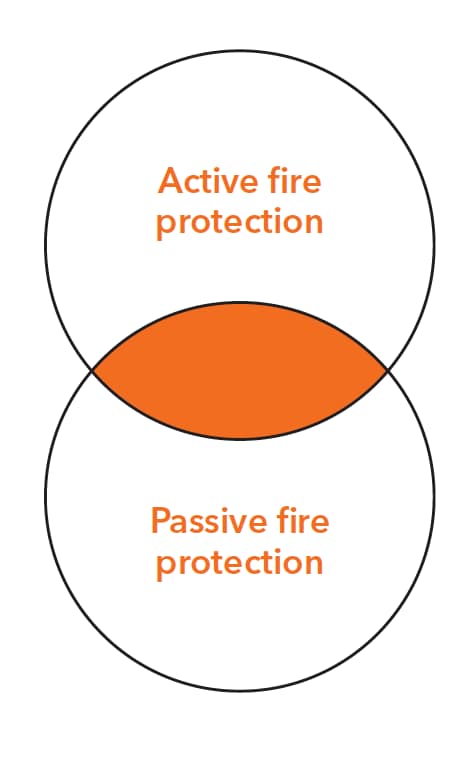
An argument for active fire and passive fire protection systems
While AFP systems are highly regulated and must conform to strict installation, maintenance and inspection guidelines established by the NFPA and enforced by the local AHJ, passive systems often take a back seat. There is a valid argument for both; active protection could fail due to a number of reasons, including low water pressure for sprinkler systems, or clogged or broken lines, while passive systems may allow occupants more time to flee, but do very little to stop the spread of the actual fire.
The following sections outline the various components that make up a comprehensive fire protection plan for any facility including both active and passive solutions.
Alarm and detection: The first line of defense
Coined “alarm and detection” by the industry, there are several key components of an active fire protection system that are necessary to initiate occupant action. They include:
Fire alarm control panels
These are the brains of the system. They are highly regulated and require a minimum of one annual inspection to test the activation of audible and visual devices, relay outputs, annunciators, elevator recall, release of magnetic door holders and many other functions. In addition, the control panel batteries, an integral part of the system, are required to be replaced every five years from the date of manufacture.
Smoke, flame and/or heat detectors
These sensing devices are designed for early detection of smoke and fire. They require periodic inspections and functional testing, as well as smoke detector sensitivity testing. Note: Functional testing does not mean using a magnet, but rather using canned smoke or an equivalent.
Audible and visible alarm systems
These include alarms (horns/bells/speakers) connected to the detection system and strobe lights. These components are tested as part of the annual inspection.
Other key elements of the system include:
- Manually activated pull stations
- Voice communication systems
- Procedure and means for notifying the fire department, including the use of central station monitoring via DACTS (Digital Alarm Communication Transmitters)
Evacuation planning
- A written plan should include procedures for notifying all appropriate emergency services, creating an internal emergency response team and conducting regular drills.
- A plan for evacuation should include a means of egress that outlines adequate numbers of well-maintained routes of escape. The egress route maps should be posted in conspicuous locations available to all occupants. As part of the plan certain considerations need to be taken into account:*
- From any point in the building, each occupant must have at least two routes of escape, clearly marked and readily accessible with no obstructions. Those routes must properly show direction of travel and use photo luminescent markings where required by the local AHJ.
- Plans must adhere to a maximum travel distance to an exit (100 feet in facilities not equipped with automatic fire suppression sprinklers; 150 feet in sprinkled facilities; and 75 feet in facilities with “high hazard” contents, including contents that will burn with extreme rapidity, or from which dense smoke, poisonous fumes or explosions are likely in a fire situation).
- The routes must contain flame-resistant interior finishes (e.g. carpets, draperies, upholstered furnishings).
- A designated safe relocation or muster area must also be identified and communicated to the building occupants. As an added safety measure, internal fire marshals should be appointed to take roll call at the muster stations to help account for all occupants.
Sprinkler systems: Another crucial piece of the puzzle to extinguish fires
The purpose of fire sprinkler systems is to provide an appropriate amount of water to extinguish fires before they can grow and spread. There are various types of sprinkler systems that can provide the right kind of protection for the specific kind of setting in which they are installed. The types of fire sprinkler systems include wet pipe, dry pipe, deluge, antifreeze and pre-action fire sprinkler systems.
Automatic fire sprinklers have been in use since 1874, the same year that ADT was founded. Following are a few statistics provided by AFSA (American Fire Sprinkler Association) to keep in mind:
- According to the National Fire Protection Agency*, fire sprinklers are a highly effective and reliable part of a building’s fire protection system. They can help prevent the spreading of fires in their early stages—before they have the potential to cause severe injury to people and damage to property.
- When one fire sprinkler head goes off to fight a fire, the entire sprinkler system does NOT activate. Sprinklers react to temperatures in individual rooms.
- The chance of a fire sprinkler accidentally going off is extremely remote because sprinklers react to heat in individual rooms—according to NFSA (National Fire Sprinkler Association).
- Installation of fire sprinklers can result in discounts on insurance premiums.†
- Fire sprinklers are designed to immediately respond to a fire while it is still small, help control the spread of deadly heat, flames and toxic smoke—whether or not the occupants have appropriately responded to the signaling smoke alarm. In this way, fire sprinklers can make up for human error, and may provide life-saving cushion for a time-consuming escape.
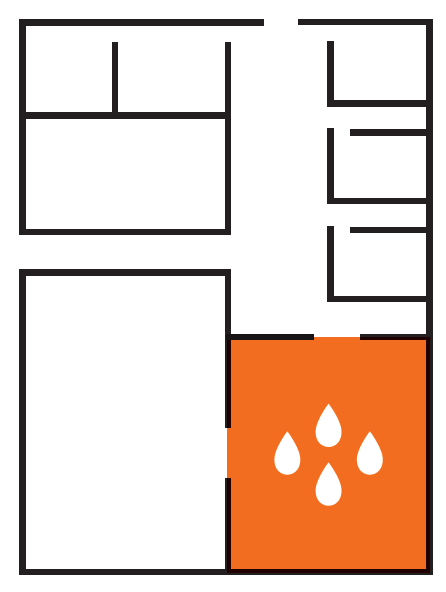
* www.NFPA.Org/25
† NFSA National Fire Sprinkler Association
Passive fire protection: The final layer
Passive fire protection components consist of several items:
Smoke, fire and combination dampers
These devices must be inspected when a commercial building first opens, one year later, and then every four years for commercial buildings and every six years for hospitals.* Note that alarm contractors may not always perform required testing. In some cases, they may only test the alarm relay from the fire alarm panel and may not mechanically exercise the damper as required by codes.
* According to NFPA 80 and 105 codes
Fire doors
Swinging fire doors are required to be tested annually and there are 13 inspection points. Overhead, horizontal, and sliding fire doors are also required to be inspected annually and also have 13 inspection points.†
† NFPA 80 code
Firestopping
A firestop is a fire protection system made of various components used to seal openings and joints in fire-resistant rated wall or floor assemblies. For penetrating cables, these can also be called Multi Cable Transits (MCTs). Firestops are designed to restore the continuous fire resistance of wall or floor assemblies, impeding the spread of fire by filling the openings in them with fire-resistant materials.
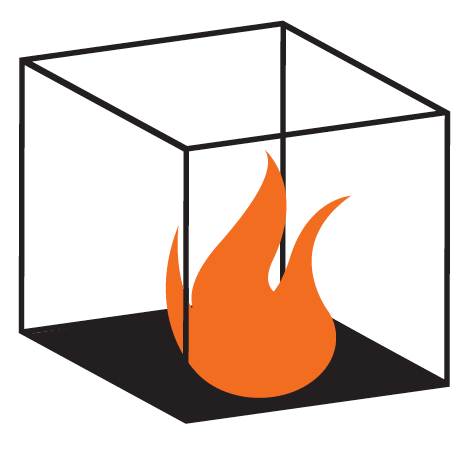
Miscellaneous components
Emergency power, illumination and emergency lighting, including:
- Exit signs
- Exits
- Pathways to exits
- Changes in elevation
- Stairs (minimum level of illumination = 10 lux / 1 foot-candle)
Emergency lighting
Routine monthly testing with an annual 90-minute load test is required, and should include verification that light beams are properly aimed.‡
‡ NFPA 101 Life Safety Code
Conclusion
Life safety plans should be as comprehensive as possible, and must include alarm and detection, suppression and passive fire protection to truly be a comprehensive plan. Passive fire protection should be addressed by owners and facility managers alike, even if the local authority is not enforcing the codes. Together, these components are critical in helping to prevent loss of life and property, in the event that a fire does occur, and mitigate overall damage.
This document, materials or presentation, whether offered online or presented in hard copy (“ADT Commercial Information Tools”) is for information purposes only. ADT COMMERCIAL PROVIDES THESE ADT COMMERCIAL INFORMATIONAL TOOLS “AS IS” WITHOUT WARRANTY OF ANY KIND, EITHER EXPRESS OR IMPLIED, INCLUDING, BUT NOT LIMITED TO THE IMPLIED WARRANTIES OF MERCHANTABILITY OR FITNESS FOR A PARTICULAR PURPOSE.
The ADT Commercial Information Tools contain ADT Commercial proprietary and confidential materials. No part of the ADT Commercial Informational Tools may be modified, altered, reproduced, stored in or introduced into a retrieval system, or transmitted in any form or by any means (electronic, mechanical, photocopying, recording, or otherwise), without the prior written permission of ADT Commercial, except as otherwise permitted by law. Prior to publication, reasonable effort was made to validate this information. The ADT Commercial Information Tools may include technical inaccuracies or typographical errors. Actual savings or results achieved may be different from those outlined in the ADT Commercial Informational Tools. The recipient shall not alter or remove any part of this statement.
Statement of Good Security Practices: IT system security involves protecting systems and information through prevention, detection and response to improper access from within and outside your enterprise. No IT system or product should be considered completely secure and no single product or security measure can be completely effective in preventing improper access. ADT Commercial products and services are designed to be part of a comprehensive security approach, which will necessarily involve additional operational procedures, and may require other systems, products or services to be most effective in ensuring network security and regulatory compliance.
Let’s start a conversation
We make it easy to switch providers, and our onboarding process is predictable, dependable and painless.


